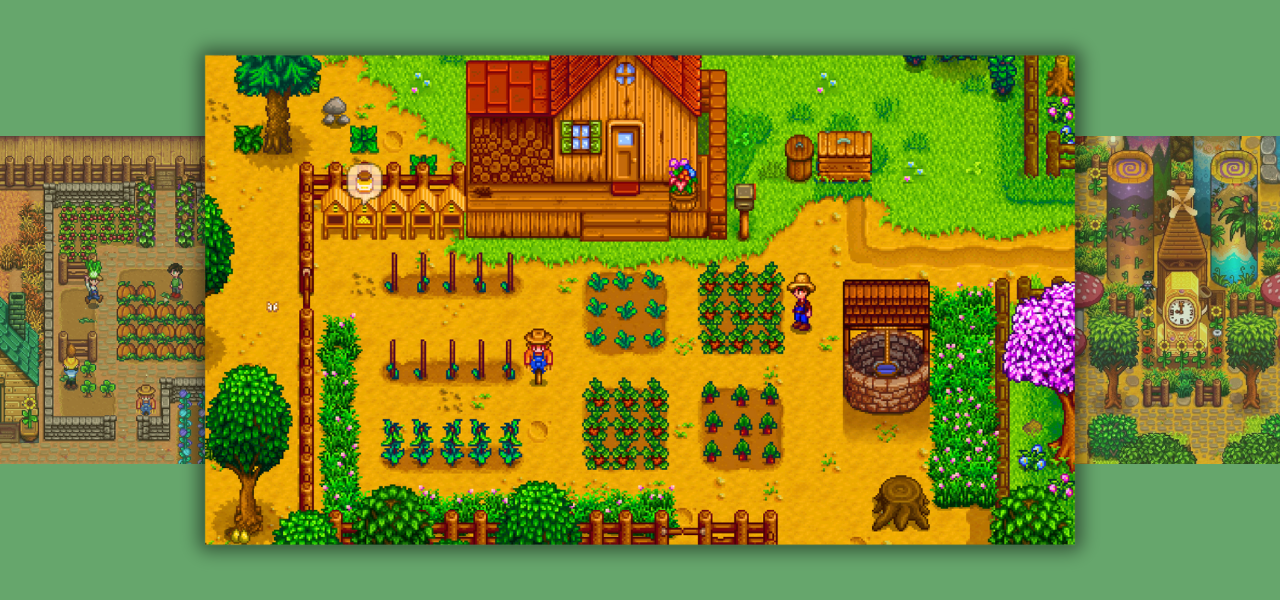Stardew Valley: A Pixel Farm Without Barriers?
Can you truly escape the hustle and bustle into a world where every day is a new opportunity? Stardew Valley offers just that: a cozy farm, a slow-paced lifestyle, and endless pixelated adventures. You can cultivate land, befriend villagers, explore mysterious caves, and simply enjoy the changing seasons. But how accessible is this idyllic life for everyone—including blind players? Let’s explore that question.
History and Key Information About the Game

Stardew Valley began as a programming exercise by a single person—Eric Barone, known as ConcernedApe. In 2012, after failing to find a suitable replacement for his favorite games, he decided to create his own version of Harvest Moon, one that would blend the best elements of classic farming sims and RPGs. He worked solo on the game for nearly four years, handling the programming, art, music, and design all by himself.
Inspired by Animal Crossing, Rune Factory, Minecraft, and Terraria, Barone didn’t just replicate successful mechanics—he improved them, adding rich lore, memorable characters, and elements of roleplaying. When the project was nearly complete, he partnered with the publisher Chucklefish, who helped with marketing and launching the game.
Following Stardew Valley’s success, Barone founded his own independent studio and announced a new project—Haunted Chocolatier, which promises fresh mechanics while preserving his signature cozy and exploratory atmosphere.
Stardew Valley was released on February 26, 2016, for PC (Windows), and later ported to macOS, Linux, PlayStation 4, Xbox One, Nintendo Switch, PlayStation Vita, iOS, and Android. On every platform, the game retained its charming style and intuitive controls.
Genre and Key Features
Stardew Valley is an indie farming life simulator with RPG and sandbox elements. It offers players complete freedom: grow crops, raise animals, explore the world, connect with townspeople, and develop your skills. Key features include:
- Open gameplay – farm, explore, interact with NPCs, or simply relax.
- Farm development – plant crops, care for animals, and upgrade your homestead.
- Social connections – build friendships and interact with village residents.
- Exploration and adventure – gather resources and uncover the world’s secrets.
- Crafting and building – create tools, furniture, and decorative items.
- Co-op mode – play together with friends.
Story: Welcome to Stardew Valley
Stardew Valley begins with a simple yet relatable story—an escape from the daily grind. Your character inherits an old farm in a small town nestled among picturesque landscapes. Tired of the gray office routine and the pressures of city life, the protagonist decides to leave it all behind and move to a place where time flows slowly and the air smells of freshly cut grass and earth after the rain.
But life in the countryside isn’t just a relaxing retreat. The farm is run-down, overgrown with weeds, and cluttered with stones. The town has its own life, full of concerns, festivals, and secrets. Some villagers are eager to help, others meet you with suspicion, and a few harbor hidden stories from the past.
At the heart of the story is not just your farm, but your relationships with those around you. You can befriend the locals, learn their stories, help them out—or simply enjoy the peaceful rhythm of rural life. Somewhere deep in the Valley lie old legends, ancient relics, and secrets waiting for the right time to be uncovered.
This isn’t just a game about planting potatoes and raising chickens. It’s a story of self-discovery, of freedom, and of how small, everyday choices shape the future. And only you can decide what that future will look like.
Gameplay and Core Mechanics

Stardew Valley is a game where you choose your own path. Do you want to become a successful farmer, covering your fields with juicy crops? Maybe you’d prefer delving into the mines for rare minerals? Or perhaps you’re drawn to battling strange creatures? Maybe you’d rather fish by a quiet lake in the morning mist? All of this is just a small part of what Stardew Valley has to offer.
Farming: The Heart of Life in the Valley
Your farm is a blank canvas waiting to be transformed into a lush garden or a profitable business. At first, it’s overgrown with weeds, but with tools and persistence, you can clear the land, till the soil, and plant seeds. Each season has its own crops, and rain helps save energy on watering. As your farm develops, new opportunities arise—raising animals, processing goods, and producing various farm products.
Exploring the Mines: Deeper, Darker, More Dangerous
For adventure lovers, the mines offer new challenges on every level. Mining is a key part of the game—ores are needed to upgrade tools, and rare minerals can fetch a high price. But the deeper you go, the more dangerous it gets—monsters lurk in the shadows, and you’ll need good weapons and armor to survive.
Fishing: Calm and Thrill
Rivers, lakes, and even the ocean shore are teeming with fish. Some can only be caught in certain seasons or weather conditions. Fishing takes skill—every fish behaves differently. Your catch can be sold, cooked, or used in quests.
Character Progression: Skills and Growth
The game features a full skill system. Every activity—whether farming, mining, fishing, or combat—relies on its own skills. As you improve, you unlock useful perks. For example, an experienced farmer can harvest more crops, and a master angler can catch rare fish more easily.
Relationships with Villagers: Friendship and Romance
Pelican Town isn’t just a backdrop—it’s a living world filled with unique characters. You can befriend them, learn their stories, and even build romantic relationships. Gifts, conversations, and participation in town events help build bonds—and if you’re lucky, you might start a family.
Home and Farm Upgrades: Comfort and Style
Progress isn’t just about crops and skills. You can expand your home, add new rooms, furnish it, and build workshops, barns, and greenhouses. All of this makes life in the Valley cozier and more productive.
Quests and Events: A Valley Full of Surprises
The game is packed with quests. Sometimes villagers ask for help, sometimes tasks arrive by mail, and other times you stumble upon something unexpected. Pelican Town also hosts regular festivals and holidays, which reward participation with valuable prizes.
Multiplayer: Farming with Friends
If solo farming feels too peaceful, you can always invite friends! Stardew Valley features a co-op mode where up to four players can run a farm together. Share duties, help each other in the mines, compete in fishing, or simply enjoy the experience together. NPC interactions and even romance are available in multiplayer, making shared play even more engaging.
Accessibility in Stardew Valley
Although Stardew Valley was not originally developed with blind players in mind, the modding community has managed to turn it into one of the most accessible games in its genre. Thanks to special modifications, the game is now almost fully narrated and allows comfortable interaction with the world, characters, and gameplay mechanics.
With the installed accessibility mods, the following features become available:
- Narration of menus, inventory, and dialogues with NPCs
- Reading of item names, quest descriptions, and chest contents
- Announcing the player’s position and surrounding objects
Thanks to these modifications, blind players can easily navigate the game world, manage their farm, and build relationships with townspeople.
Additionally, the mods provide full keyboard support, including mouse click emulation:
- Movement in the main menu is controlled with the W, A, S, D keys
- Character creation uses the arrow keys
Since the original control system in Stardew Valley is mouse-oriented, the mods add key combinations to simulate mouse clicks:
- Left Ctrl + Enter — left mouse click
- Left Shift + Enter — right mouse click
Alternative keys are also supported:
- [ — left click
- ] — right click
Note: Some menus may require using a different method if one doesn’t work. All core actions—planting, resource gathering, and combat—are adapted for keyboard and controller use. However, building structures on the farm may require manual input and a bit of practice. Despite the high level of accessibility, a few mini-games at festivals may still be inaccessible.
A mod pack and all necessary setup guides are available through the links below. With the recommended configuration, Stardew Valley can become a nearly barrier-free experience.
Conclusion: Is Stardew Valley Worth Playing?
Stardew Valley isn’t just a farming simulator—it’s a full virtual world where everyone can find their own path. The game offers deep yet relaxing gameplay, allowing players to unwind while developing their farm or to challenge themselves by exploring mines and fighting monsters. It strikes a perfect balance between freedom of choice and simple, engaging mechanics.
Whether you prefer slow-paced farm development or thrilling adventures, Stardew Valley has something for you. And thanks to the modding community, almost the entire game is accessible—even for blind players.
Stardew Valley is a game worth playing at least once!
